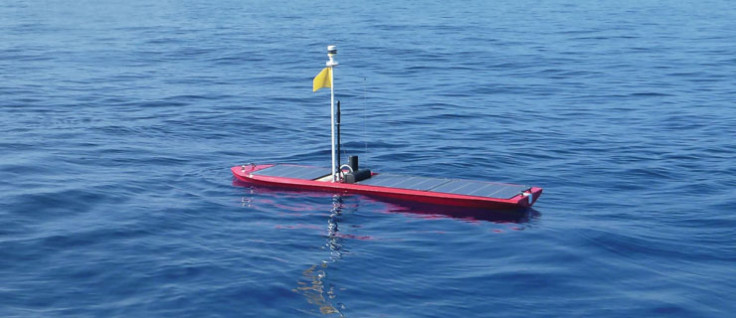Robot That Crossed Pacific Ocean Took Notes Along The Way For Scientists To Study

Diana Nyad might have recently swam from Cuba to Florida, but last December, a little robot from California company Liquid Robotics completed an even longer aquatic trek: a 9,000-mile journey across the Pacific Ocean.
Liquid Robotics’ Wave Glider robots aren’t built just for long-distance swims. The semi-autonomous robots can collect data as they go, making them perfect for oil companies looking for new prospective drilling sites, or for countries that want to secure marine boarders or guard local fisheries. The company is especially eager to put its robots to use in the service of science. To that end, they made the data from their robots’ 2011-2012 Pacific Ocean crossing available to researchers and held a competition called the PacX Challenge to find the best paper that could be made with the data.
“Our first goal was just to demonstrate that our technology was capable of such a journey; our second goal was to ask the scientific community: ‘what does this tool mean for you?’” Liquid Robotics senior vice president Graham Hine said in a phone interview.
On Tuesday evening, the company announced that University of Texas at Austin researcher Tracy Villareal grabbed the top prize in the competition: a $50,000 research grant, sponsored by oil and gas company BP, plus six months of Wave Glider use (a $300,000 value). Villareal’s winning research examined the behavior of certain species of phytoplankton – tiny floating plants that form a cornerstone of the ocean food chain.
“Our interest was in using the data set to look at whether it could detect how certain large phytoplankton species… bloom, aggregate into large floes, and eventually sink,” Villareal wrote. “This is an important step in removing carbon from the surface ocean and is a major food source for the deep sea. It happens quickly and is difficult to study with ships but is [known] to occur in the open Pacific Ocean.”
The Wave Gliders that crossed the Pacific carried a variety of sensors, including acoustic devices, instruments that can measure the turbidity and salinity of the seawater underneath, and other tools that can gauge the weather above the robot. The Wave Glider also carries a tool that can detect the presence of chlorophyll, a key pigment that plants use to convert sunlight into food. Finding chlorophyll can be a way to calculate the biomass of the plankton in the water that the robot’s travelling through.
While the data set wasn’t perfect (a couple of robots got lost along the way), Villareal was able to determine that two Wave Gliders passed through a large phytoplankton bloom in the Western Pacific. The bloom was located at the meeting place between two ocean eddies, which had been predicted by other researchers. All in all, the gliders show great potential for use in phytoplankton research, Villareal wrote.
Hine thinks the Wave Glider is an important tool to open up new avenues of ocean exploration and research. It’s cheaper and less intrusive than a big research boat -- and, since the Wave Glider runs on solar power, it’s much greener, too.
“The Wave Glider can not only go out incredibly long distances, [it] can also act a bit like the Mars rover,” Hine said in a phone interview. “If it sees something interesting it can go check it out; you’re not just sending drifters that have to go with current.”
The possibilities for research are myriad, Hines says. One Wave Glider has already been conscripted in efforts to track great white sharks near the San Francisco Bay. The robot (named Carey), moves around the coast, between hot spots that sharks are known to frequent, and picks up on the acoustic signals from great whites and other sharks that have been previously tagged by scientists.
Hine says the company would love to hold another scientific competition again. He’d also love to see a Wave Glider explore Antarctic regions, maybe with some new gadgets in tow, like something that could analyze any DNA samples found in the water.
“We’re excited to see the science that comes out of this,” Hine says.
© Copyright IBTimes 2024. All rights reserved.





















